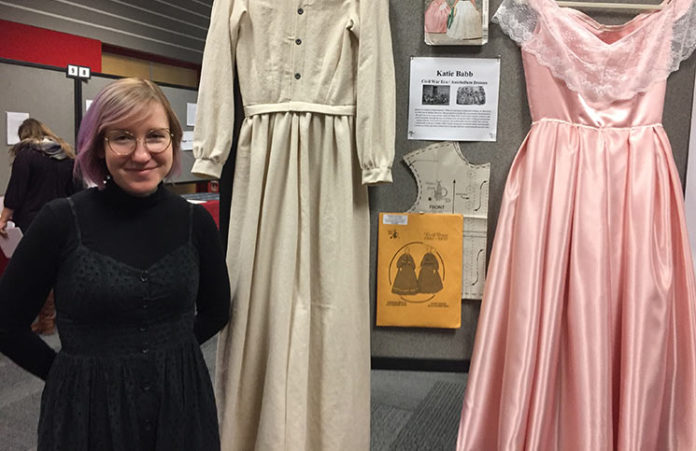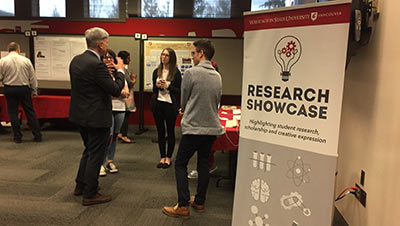
Katie Babb came to Washington State University Vancouver’s Research Showcase armed with a poster presentation on sewing and dresses in the 1800s.
As a junior studying fine arts at the university, she had never participated in a research showcase before, which is not particularly surprising since showcases are almost always focused on scientific research. This year at WSU Vancouver was different though, as officials opened up the showcase to non-scientific disciplines as well as scientific ones. And several fine arts students decided to take part.
“One of my instructors told me this was happening, and now there’s a whole group of us participating,” Babb said of her fellow fine arts students. “You can do science research, and everybody knows about that. But you also need to do research for artistic things, and it’s great that we get to show that off this year.”
Babb’s project was to look at sewing in the 1800s through the eyes of social justice. In her project, she researched the materials used, labor methods and environment around how dresses were made for black slaves and white women during the Civil War era.
“I was hoping that by seeing them side by side you can really see the difference in fabric quality, lace, tailoring,” Babb said. “Back then if you were white you would get your dresses tailored, whereas slaves did not have that option unless they made their dresses themselves.”
Dresses for white women were made of fine silk and lace, whereas those for slaves were often made of burlap, sometimes from leftover sacks.
“That’s just one small aspect of the inequalities,” Babb said. “Clothing is what you wear in front of the world, though. And it says a lot if you don’t have a choice about what you wear. Going through this, I didn’t realize just how uncomfortable the fabric was for slaves.”

Christine Portfors, associate vice chancellor for research and graduate education, said the expanded showcase was a great success, with far more students participating and attending than in recent years.
“It was great,” Portfors said. “It was busy all day. The talks were really good and quite well attended, great questions. People commented on how much energy there was in the poster session. I think it was a really successful event.”
Along with expanding the showcase to non-science disciplines, this year was also the first to invite contest judges from the community, including an entrepreneur and an engineer. The goal of that is to better integrate the university with the outside business community so that eventually new partnerships can form, she said.
“It was successful, so we want to do even more of that next year,” Portfors said. “One of our judges was from BDI Analog Devices, and they’re really interested in expanding their outreach with students. They also recently had an engineering student intern with them and they hired him.”
While the fine arts students were a positive addition to the showcase, the bulk of the event was still focused on science and engineering.
Kesondra Key, an environmental science major at WSU Vancouver, did her poster presentation on “Pacific Northwest Wildfire Effects on Air Quality,” looking at the impacts of the Eagle Creek Fire from September to November of 2017.
“I noticed that the air in 2017 was really bad,” Key said. “I looked at the air quality index but also at gaseous chemicals. Most assessments focus on particulate matter, but I thought it was important to show all of it.”
That year was the worst air quality on record for Oregon and Washington, with fires burning in both states and bad air also descending on the region from wildfires in British Columbia.
Beyond the particulate matter, wildfire gasses that year also included carbon dioxide, sulfur dioxide, nitric oxide and ozone.
Key said she wants to look at data from 2018, but there’s not enough available yet, she said.
Kiana A. Tanaka and David Ramsay, both seniors in the Psychiatry Department, also participated with a poster on “Perceived Risks and Benefits of Electronic Cigarettes Among Cigarette Smokers and Electronic Cigarette Users.”
In their research, they highlighted the different ways that e-cigarette users and cigarette smokers perceive the risks of their behavior. The goal of that information would be to try to create targeted health campaigns at either group, Ramsay said.
“E-cigarette use has increased dramatically over the past several years,” Ramsay said. “We think that’s because people think it’s safer. And those perceptions influence actual behavior.”
Smokers, on the other hand, were more aware of the risks of their behavior. So, a goal for a campaign aimed at smokers might include information about how e-cigarettes are safer than cigarettes, but a campaign aimed at e-cigarette users might point out that there are dangers associated with e-cigarettes as well and suggest ways to cut down on use.
“We’re really interested in what kind of health messages we should use in targeting these groups,” Ramsay said.
Both said they were thrilled to have the chance to show off their work to the public and other students.
“It’s a chance for students to be able to present things they’ve been working on with research,” Ramsay said. “We get to talk with lay people. And research that you do, you can use that as part of your academic resume.”
It also helps prepare students for the real world, Tanaka said.
“It helps you prepare for public scrutiny and helps you build skills for the job you want to get,” Tanaka said.
WSUV Research Showcase Winners:
Undergraduate Poster Presentation
First place ($300 award) – Holly Slocum, “Reconstituting Electronic Literature”
Co-presenters: Mariah Gwin, Andrew Nevue, Kathleen Zoller, Moneca Roath
Graduate Poster Category
First place ($300 award) – Alexandra Jackson, Human Development – “Food and Nutrition within the Parent-Young Child Dyad”
Undergraduate Podium Presentation
First place ($300 award) – Alysha Henderson, “Assessing the Effects of an Emerging Pathogen on Western North American Amphibians”
Co-presenters: Monica Draculan, Chelsea Osbron, Gretchen Rathke
Graduate Podium Presentation
First place ($300 award) – Sreenidhi Krishnan, “Materials, Meanings, and Mise-en-scène: Understanding Life and Livelihood on Production Sets”



